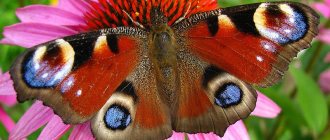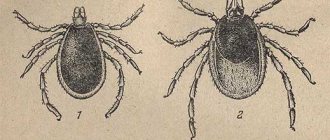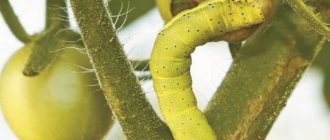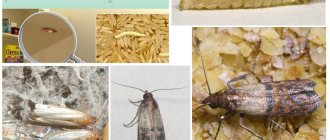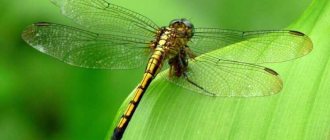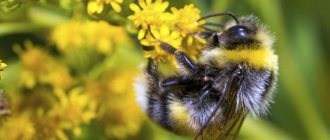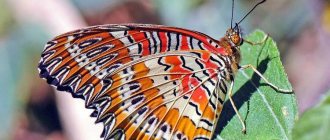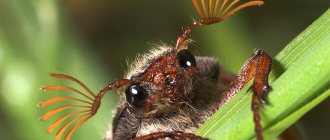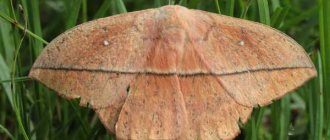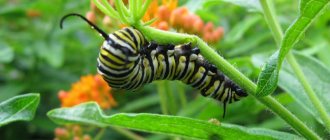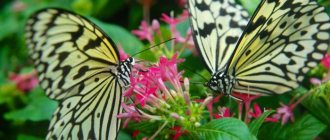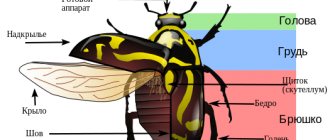As children, many of us believed that the velvety surface on the wings of butterflies is nothing more than pollen. There were even those who tried to “cure” a caught butterfly by placing it on a plant so that it would be pollinated and be able to fly further. In practice, everything is much more complicated. The wings of these insects are covered with a dense layer of tiny scales that perform many different functions: from increasing lift to suppressing vibration during flapping. Hence the name - Lepidoptera. Today we will get to know this species in a little more detail.
Butterfly wing under a microscope
Representatives of the order Lepidoptera
Lepidoptera, or Lepidoptera (from the merger of the words “wing” and “scale” in ancient Greek) is an order of insects distinguished by a dense covering of hair-scales on the wings. Most often they are simply called butterflies, moths or moths.
Archaeologists have found remains proving that butterflies existed during the Jurassic period.
Fossilized remains of a butterfly from the Jurassic period
In everyday life, they use a division into lower and higher butterflies, where the lower are micro-lepidoptera, primitive butterflies, and the higher are macro-lepidoptera day and night butterflies.
Separately, it is worth mentioning how to distinguish daytime from nocturnal insects, with the exception of their lifestyle.
- Day butterfly. When resting, folds its wings flat over its back. More brightly colored than night.
- Moth. In a calm state, it keeps its wings open, partially or completely masking its body. The ratio of body length to wing length is greater than that of diurnal individuals. The antennae are also thicker and more branched.
As for etymology, the Russian name “butterfly” comes from the Old Slavonic “grandmother”. Pagans believed that the souls of dead relatives visited the living, reincarnating as insects. To this day you can hear Old Believers in villages and villages calling them “babuchka”, “grandmother”.
The familiar “moth” is also derived from the Old Slavonic words “to dangle”, “revenge”, which means “to spin around its axis” or “to mix in jerks”.
The word “moth”, according to one version, is derived from the Old Slavonic “grind” meaning “to destroy.” According to another, from the Irish mil meaning “small animal”.
Butterfly sizes
Body sizes vary widely: from the smallest moths (3-8 mm in wingspan) to the largest day butterflies, ocelli and noctuids (25-30 cm). Representatives of the squad have four wings. The latter are covered with modified hairs - scales, sometimes brightly colored and forming characteristic “patterns” on the surface of the wings.
Junonia atlites. © 2016 Jee & Rani Nature Photography
Types of lepidopteran insects
Zoologists have recorded more than 158 thousand species, subspecies and families of these flying insects.
Lepidopterist entomologists study the butterfly order.
Since the scientific classification system is constantly modified and adjusted, the most understandable is considered to be the one in which all lepidopteran insects are divided into four suborders:
- primary toothed moths;
- trunkless;
- proboscis;
- heterobatmy.
This classification is used by butterfly collectors (lepidopterophilists). Let's look at each suborder in a little more detail.
Toothed moths
The smallest lepidopteran representatives of the species that existed back in the time of dinosaurs. The size of the insect varies from 4 to 15 mm. The gnawing type oral apparatus consists of asymmetrical mandibles, where the upper jaw predominates over the lower jaw. A distinctive feature is the long and large antennae, the size of which is approximately 75% of the size of the wings.
This subgroup includes about 160 species of butterflies. The most famous representatives are Micropteryx calthella.
Small wing of the family Micropteryx calthella
Proboscis
Officially, this species appeared in the systematization of lepidopteran insects relatively recently - in 1967. Until this time, all proboscis moths were classified as toothed moths.
This is the smallest subgroup, which includes only butterflies of the Heterobathmiidae family.
Mourning moth butterfly
Proboscis
One of the largest suborders, including more than 150 thousand species of Lepidoptera. Representatives of the Sailfish family are considered the most famous and sought after among collectors:
- Swallowtail - the wings have an attractive, bright yellow or ash color, over which there is a pattern of black lines. At the moment, the swallowtail is listed in the Red Book as an endangered species of insect.
Swallowtail
- Glory of Bhutan - the upper wings are rounded, and the lower ones have three branches. The color is dark, with red-white-yellow “eyes” that warn predators of danger. Habitat: China, Thailand, Northern India.
Glory to Bhutan
Uncontrolled deforestation in India has led to a sharp decline in the population of the Glory of Bhutan butterflies. Currently, these insects are under government protection.
- Queen Alexandra's birdwing is the largest representative of daytime butterflies on the planet. The wingspan reaches 28 cm. The intricate interweaving of green and black lines in color is reminiscent of a tropical flower or ancient brocade.
Birdwing of Queen Alexandra
In this same subgroup it is worth highlighting insects of the Nymphalina family. Their peculiarity lies in their wide wings with thick and rough veins, as well as in the variety of color options. The following butterflies belong to the order Lepidoptera:
- Admiral - found almost everywhere - from city gardens to mountain peaks. It can be unmistakably recognized by its black wings, with bright red semicircular stripes and white spots.
Admiral
- The day peacock is a long-lived butterfly that can live for a total of about a year. For these qualities, it is often used at exhibitions and even kept at home. In the corner of each of its wings there is a yellow circle, in the center of which there is another one - brown and a light blue outline.
Peacock eye
- Urticaria - feeding on nettle nectar and resting on the leaves of the plant, this butterfly is not afraid of being stung. She got her second popular name - chocolate girl - for her coloring, reminiscent of chocolate-caramel stains.
Hives
Also among the proboscideans, the most famous butterflies are the blueberry and the pied moth.
General characteristics of Lepidoptera
Lepidoptera are one of the most numerous orders of insects belonging to the phylum arthropods. A characteristic feature of all representatives of the order is four wings covered with a fine layer of modified scales. Their coloring creates bizarre and unique patterns on the surface.
Butterfly wing under a microscope
If we draw an analogy with other insects, then butterflies are a rather “young” group. The first representatives appeared with the flowering plants in the Cretaceous period.
Butterflies are distributed throughout the world, right up to the border of permafrost. Those species that live in temperate latitudes need wintering. More often, the insect survives the cold period in the form of a pupa, less often - in the adult stage. In the latter case, lepidoptera can migrate over vast distances, gathering in huge flocks.
Monarch Butterfly Migration
More than 15,000 species of butterflies are found in the CIS countries.
Common to our latitudes, urticaria, mourning grass, peacock's eye and buckthorn are able to survive the winter as adults without leaving their native lands. When spring comes, they will be ready to reproduce again.
The butterfly's two faceted eyes are capable of recognizing colors, but unlike humans, they see the world in the ultraviolet part of the spectrum. This feature allows zoologists to control the behavior of flying insects using special lamps and conduct observations at night.
How a butterfly sees the world
Butterflies are an important part of the ecosystem, since many plants are pollinated mainly or only by them. Caterpillars serve as food for many small animals and birds.
There is also a downside - the voracious larvae of butterflies can cause significant damage to vegetable crops and plants used by humans. In some cases, they can leave entire gardens and even forests without leaves.
Reproduction and development
Lepidoptera are insects with clearly defined sexual dimorphism. Sexual dimorphism in wing color can be expressed in the ultraviolet part of the spectrum and is invisible to the human eye. The females of many Lepidoptera secrete odorous substances (pheromones), the odors of which are detected by the males with olfactory receptors. The sensitivity of the receptors is quite high, and males detect the scent of a female from a distance of several tens and sometimes hundreds of meters. In concentrated form, the smell of pheromone is easily detected by humans.
Eggs are usually laid by Lepidoptera directly on the food plant of their caterpillars. Females glue the eggs to the substrate using the secretion of the accessory sex glands. Only some butterflies have been noted to disperse eggs directly onto the soil near food plants. Eggs are laid singly or in groups. Usually the egg laying remains unprotected.
The transformation is complete. Butterfly larvae are called caterpillars. The larvae (caterpillars) have a cylindrical 10-segmented body and a strongly sclerotized head, on which there are 6 pairs of simple ocelli and very short 2- or 3-segmented antennae. The mouthparts are gnawing with well-developed powerful mandibles. The thoracic segments bear 3 pairs of dismembered legs, which are used only for supporting or grasping leaves during feeding. For movement, abdominal fleshy pseudopods with a number of hooks on their soles are used. The covers of caterpillars are covered with bristles, which have a strictly fixed position in each species. With age, some caterpillars develop secondary hair that thickly covers the entire body.
Sicklewing (Polyploca ridens)
Caterpillars of most species lead an open lifestyle. Some forms live in the soil. Finally, a number of species settle in plant tissues (leaves, wood, etc.), on which they feed, making passages in them. The pupae of almost all Lepidoptera are covered: the body appendages are tightly fused to the integument and are motionless. Only certain segments of the abdomen retain the ability to move. Caterpillars are extremely diverse in their lifestyle, although they are inferior in this regard to Diptera or Coleoptera. Below are the main life forms of caterpillars.
1. Free-living caterpillars . They typically feed on leaves directly on plants. Caterpillars associated with woody vegetation are often covered with secondary hair and are often equipped with various outgrowths. On the contrary, caterpillars associated with grasses usually lack dense hair. For some free-living caterpillars, special protective skin glands are known. An important feature of many free-living caterpillars is their cryptic appearance. In some cases, not only the color and shape of the body, but also behavior are involved in creating the cryptic effect. 2. Case carriers . This life form is represented by caterpillars that live inside special cases, which they build from thin twigs, dry leaves or grains of sand, gluing them with silk. Typical examples of such caterpillars are bagworms (Psychidae). Bagworm cases can often be seen on tree trunks, on leaves, or simply on the wall of a house and on a fence. The caterpillars also pupate in the covers. 3. Soil-dwelling caterpillars . Among the caterpillars, there are relatively few soil inhabitants. These are predominantly gnawing cutworms from the subfamily Agrotinae. They are characterized by a digging head and polyphagia. 4. Leaf rollers . This group includes caterpillars that secrete silk abundantly and live in leaves rolled up or woven with silk thread, on which they feed. Examples of leafrollers include some leafrollers (Tortricidae) and moths (Pyralidae). 5. Spinners . Biologically close group to leafworms. Spinner caterpillars weave silk threads around the branches of trees and shrubs, forming nests in which they live. Typical representatives of spinners are ermine moths (Yponomeutidae), which not only feed, but also pupate in nests. 6. Codling moths . These caterpillars lead a typical hidden life inside fruits and seeds. Codling moth caterpillars lack any pattern, usually white or yellow, sometimes pink or even red. 7. Drillers . A clearly defined life form of caterpillars that live inside the branches and trunks of tree species, as well as in the roots. In terms of diet, drillers are xylophagous. They are characterized by multi-year development cycles. In terms of adaptive morphological characteristics, borers are similar to codling moths. 8. Miners . This group includes caterpillars of a wide variety of families. Unlike borers, leaf miners live inside the green parts of plants, usually inside leaves. When caterpillars eat away the inside of a leaf, a cavity (mine) is formed, clearly visible from the outside in the form of white spots. Epidermal miners (sap eaters) are capable of sucking juice from plant cells. 9. Aquatic caterpillars do not represent a single life form, since the nature of their habitat use is quite diverse. Systematically, all Palaearctic aquatic caterpillars belong to moths (Pyralidae). From time to time, caterpillars build cases in which they are carried by the current to a new plant. At older ages, caterpillars switch from a mining lifestyle to a cap-bearing lifestyle.
White peacock (Anartia jatrophae jamaicensis), female
Caterpillars pupate either in the soil or openly on plants. In the latter case, the caterpillars spin a cocoon before pupation (for example, cocoon worms, peacock moths, moths, and others). Caterpillars of rhopalocera do not spin cocoons and many of them attach to plants during pupation. The pupae of these butterflies have a protective coloration, and their color often depends on the color of the substrate on which pupation occurs. In swallowtails (Papilionidae) and whitetails (Pieridae), pupae are attached to plants by a silk belt. In nymphalids (Nymphalidae) and marigolds (Satyridae), pupae do not have a girdle and hang upside down on plants. Caterpillars often pupate in bark crevices or under loose bark. In this case, the caterpillars make a rare cocoon or form a cradle.
Within the order Lepidoptera, there is a significant diversity of life cycles. In temperate climates, both monocyclic and polycyclic species are found. Caterpillars or pupae usually overwinter; overwintering of adults and eggs is less common. For example, among cutworms (Noctuidae), 45.5% of European species overwinter in the caterpillar stage, 32.5% in the pupal stage, 17% of species have embryonic diapause, and only 5% of the species composition overwinter in the adult stage. As a rule, for each species the wintering stage is confined to a strictly defined stage of ontogenesis.
Signs of Lepidoptera
Lepidoptera include insects with the following distinctive features:
- Wings - two pairs of wings are covered with scales, where each scale is a flattened hair. Colors are variable. The larger the butterfly, the fewer wing beats it makes per second. The movements of the insect are chaotic, irregular, zigzag. Thanks to this feature, it is difficult for birds to catch them in flight.
- Oral apparatus . Most butterflies have a special proboscis for absorbing liquid food. Its length allows you to consume nectar even from deep flowers or cracked fruits/berries. During flight and rest, the proboscis is twisted into a spiral. The primitive representatives of the order have working upper jaws (mandibles), just like a caterpillar. Some adult individuals have no oral apparatus at all, as the butterfly continues to consume the protein stored during the larval stage of development.
- Development with complete transformation. The adult mates and lays eggs on the “food” plant. The hatched caterpillars eat the plant. A fully grown caterpillar turns into a pupa, becoming covered with a hard shell in which the formation of an adult butterfly occurs.
Butterfly proboscis under a microscope
Butterfly feeding
The main source of food for butterflies is nectar. Flying from flower to flower when feeding, butterflies, along with Diptera, Hymenoptera and beetles, actively participate in plant pollination. It is noteworthy that butterflies, having a fairly long proboscis, visit flowers not only with openly located sources of nectar, but also with nectar deeply hidden in the spurs of flowers or at the bottom of the tubular corolla and, accordingly, inaccessible to other insects. Due to their morphology, the flowers of many carnation and orchids can only be pollinated by lepidoptera. Some tropical orchids have special adaptations for pollination of flowers by lepidoptera.
In addition to nectar, many butterflies willingly absorb sap flowing from wounded trees or fruits. On a hot summer day you can observe large concentrations of white moths (Pieridae) near puddles. Other lepidopterans also fly here, attracted by water. Many diurnal butterflies often feed on the excrement of vertebrates. Regardless, aphagia occurs in the most diverse families of Lepidoptera: butterflies do not feed and their proboscis is reduced. Among insects with complete metamorphosis, Lepidoptera are the only large group in which the transition to aphagia is so often observed.
Among Lepidoptera there are certain species with different feeding modes. Thus, many true moths (Tineidae) switched to feeding on tinder fungi, and some species of this family specialized in feeding on wool or hair, developing in a natural environment in the burrows and nests of vertebrates. Some representatives of real moths, for example the clothes moth (Tineola biselliella), have become synanthropic and damage woolen products in residential buildings and warehouses. A special feeding regime is characteristic of a small group of moths (Pyralidae) that live in honey bee hives or bumblebee nests, feeding on wax.
Urania leilus
The predatory caterpillars deserve special attention, giving an idea of the wide adaptive capabilities of the order. Facultative predation is often observed among the large noctuidae family. Such caterpillars can eat aphids found on the plant, sometimes attacking smaller or weakened caterpillars. There are few true predators among Lepidoptera. A widely known species of cutworm is Coccidophaga scitula, whose caterpillars specialized in feeding on scale insects. The behavior of the caterpillars of the alcon blueberry (Phengaris alcon) is extremely peculiar. Its caterpillars in the first instar feed on gentian, but after the first molt they penetrate into the nests of ants, where they destroy their larvae. The caterpillars of this blueberry have developed skin glands that secrete a substance attractive to ants.
Where do Lepidoptera live?
Lepidoptera are distributed throughout the planet. We list their habitats in six zoogeographical regions:
- Palaearctic. There are more than 22 thousand species of butterflies, of which 1600 are diurnal. About 4,500 species have been recorded in European countries alone.
- Nearctic . More than 14 thousand species of Lepidoptera are found in this area. More than 700 of them are diurnal butterflies.
- Neotropics. More than 45 thousand different species of butterflies have been recorded. Due to the inaccessibility of the regions of South Africa, many species may still not be described by scientists.
- Afrotropics. On the territory of this biogeographical region, it was possible to count about 3 thousand species of diurnal butterflies.
- Indo-Malay region. About 800 species of diurnal lepidoptera have been described in the Philippines alone. In general, the region has about 4 thousand species of butterflies.
- Australian region. Common species with the Indo-Malayan region, but unique insects are also found. For example, more than 800-day-old butterflies have been described in New Guinea. Directly in Australia – about 400.
The unremarkable surroundings of the provincial village of Tingo Maria in Peru, this is the place with the largest concentration of lepidopteran species in the world.
The distribution of Lepidoptera in the territory of eternal snow has not been fully studied, however, in the north of Yakutia, not far from the Arctic Circle, it was possible to record the Arctic Apollo butterfly.
Arctic Apollo butterfly
Body structure of lepidopteran butterflies
The body of lepidopteran butterflies is divided into three sections: head, chest and abdomen. Let's take a closer look at each of them.
- Head . Sedentary, round. The spherical eyes and a pair of antennae emerging from the frontal part between them are clearly visible. In the lower part there is an oral apparatus - a spiral proboscis, with the help of which the insect absorbs plant nectar and fruit juice. Often, on the left and right sides of the proboscis, there are sensory organs densely covered with scales.
- Breast . Consists of three segments: anterior, middle and posterior. Each has a pair of legs attached. The mesothorax and metathorax each bear a pair of wings, reinforced by a system of tubular vein formations.
- The abdomen is a cylindrical body consisting of ten segments, of which the last 2 or 3 are transformed into genitals. By their shape, experts determine the subspecies of butterflies.
The legs of a butterfly consist of five segments: coxa, trochanter, femur, tibia, and tarsus. First of all, the limbs of this insect are designed for fixation on various surfaces, since most of the movement is carried out through flight.
Some species of butterflies have taste buds on their legs: until the butterfly touches the liquid with its paw, it will not open its proboscis to drink.
The entire body of the lepidoptera is covered with a hard cuticle, consisting of three layers:
- The epicuticle is the thinnest and most fragile layer.
- The esocuticle is a harder tissue. It is the connecting link between the inner and outer layers.
- Endocuticle is a dense tissue formed by polyprotein structures and chitin. Chitin is worth mentioning separately: although it is amazingly light, it is very durable, insoluble in alkalis and organic solvents.
Schematic body structure of a butterfly
General characteristics of the order of butterflies and representatives
The main characteristic of butterflies is the presence of tiny colored scales on their wings, the location of which determines the pattern of the wing.
These scales are easily erased, so the pattern of specimens that have flown for a long time is not as bright as that of fresh ones.
The mouthparts of butterflies in most cases are represented by a long, spirally twisted proboscis.
Sitting on a flower, the butterfly straightens its proboscis, plunges it into the depths of the flower and sucks out the nectar. Some butterflies do not feed and do not have a proboscis. Based on the nature of their activity, butterflies are divided into two large groups.
Daytime butterflies fly, feed, lay eggs during daylight hours, usually in hot sunny weather, and hide in shelters at night. Moths, on the contrary, sit in shelters during the day and fly actively at dusk and at night.
Day and night butterflies can be easily distinguished by their appearance. Daytime butterflies have very wide wings (Fig. 13, 4), which they fold when at rest, moving vertically upward and pressing the inner brightly colored side against each other. Their body is slender, their chest and abdomen are thin, and their antennae end in a club. Daytime butterflies are also called club-whiskers.
Moths have narrower wings, and they most often fold them like a roof over their abdomen or keep them spread out to the sides.
The chest and abdomen of these butterflies are usually thick (Fig. 13, 1), the antennae have a varied structure, but are never club-shaped.
The flight of most daytime butterflies is slow, fluttering, while those of night butterflies are swift, with frequent flapping of their wings.
Butterfly larvae are called caterpillars. A characteristic feature of caterpillars is the presence of fleshy false legs on the abdominal segments, the soles of which are equipped with hooks that allow the caterpillars to firmly hold on to plants.
Unlike the true articulated thoracic legs, the false abdominal legs are not divided into segments.
Almost all caterpillars feed on plants and live openly on trees, shrubs and grasses. The caterpillars of some butterflies eat grain, flour, wool, wax and other valuable products and materials.
Most butterflies are of no economic importance; they serve as an ornament to nature and deserve protection. Only a few species are beneficial, such as silkworms. There are several more harmful species that cause damage to agriculture, forestry, horticulture, as well as stored products and products.
Cabbage (butterfly)
One of the most common daytime butterflies, well known for being a nuisance in rural areas. This large white butterfly is difficult to find far from agricultural fields and vegetable gardens.
Although its caterpillars are capable of developing on wild cruciferous plants, cabbage grass concentrates in cabbage fields and vegetable gardens.
The caterpillars especially damage cauliflower and white cabbage. They also develop on rutabaga, turnips, rapeseed, mustard and other cruciferous crops.
Rice. 13. Representatives of the order Lepidoptera: 1 - odorous woodborer; 2 - moth; 3 — fingerwing; 4 - multicolor
Cabbage grass is very widespread, but is not found in Siberia due to severe frosts and in Central Asia, where heat and dry air are unfavorable factors.
Butterflies fly in early spring, in the Moscow region, for example, from early May until late autumn. These are heat-loving and sun-loving insects; in cloudy weather or when the temperature drops, they hide among plants. They fly only in the daytime from 7 a.m. to 6 p.m. They feed on the nectar of flowers.
The female lays eggs in groups of 20 to 200 on one leaf of cabbage or other cruciferous vegetables. In total, the female can lay up to 250 eggs.
Young caterpillars live in clusters and feed by scraping the pulp of the leaf. As they grow, they spread and begin to eat all parts of the leaf except the thick veins.
Adult caterpillars climb onto fences, tree trunks and other objects, attach their bodies with a silky belt in a vertical position with their heads up and turn into pupae.
The pupa is painted in a color similar to the color of the object on which the caterpillar pupated, which makes it unnoticeable to enemies.
The cabbage moth often multiplies in large numbers and destroys cabbage on many thousands of hectares. If the caterpillars eat all the cabbage in the breeding areas, they crawl into neighboring fields. Caterpillars cause noticeable harm even when their numbers are small: their green excrement falls between the leaves of the head of cabbage and causes it to rot.
Over the summer, several generations of the pest develop. Butterflies that have accumulated in large numbers sometimes migrate over considerable distances.
Cabbageweed is part of a large group of white butterflies, among which there are many harmful species - rutabaga, reptile, hawthorn, etc.
Fall armyworm
As the name of the species indicates, the butterfly is a pest of winter cereals. However, in a number of areas it also damages sugar beets, vegetables, potatoes, and in the south, cotton and tobacco.
Cutworms are nocturnal moths, which for this reason are often called moths.
The small head of these butterflies is surrounded by a hood of thick fluffy hairs and looks like the head of an owl, hence their main name - cutworms.
A feature of the biology of most cutworms is the caterpillars’ negative reaction to light. Therefore, during the day the caterpillars hide between lumps of soil, and at night they crawl onto the plants on which they feed.
Fall armyworm can grow on more than 50 different plant species. However, the pest concentrates on agricultural fields. This is due to the instinct of females to choose areas with sparse vegetation for laying eggs.
Therefore, females are attracted to plowed fields of winter crops or fields of potatoes and vegetables.
Females feed on flower nectar for a long time before laying eggs. The eggs are laid one at a time in plant debris in fields or on weed leaves. One female can lay up to 2000 eggs. Caterpillars gnaw plant stems at the base and often also eat germinating grains.
When the number of caterpillars is 10 copies per 1 m2, winter crops are greatly thinned out and sometimes completely destroyed.
Having reached maturity, the caterpillars of the winter cutworm burrow into the soil to a depth of 5 - 25 cm, where they create elongated caves with smooth walls, where they turn into pupae.
The caterpillars spend the winter in such caves and turn into pupa in the spring.
Butterflies and caterpillars of the winter cutworm have a monotonous color: the caterpillars are earthy-gray with a smooth body; The forewings of butterflies are brown, sometimes almost black, with two kidney-shaped spots in the middle part.
Apple and plum moths
The caterpillars of these butterflies are known to everyone. These are the same pests that cause great damage to gardening, causing worminess in apples, plums, and less often pears, apricots, and sloe.
The female codling moth lays up to 100 eggs singly on leaves or young fruits. A week later, caterpillars emerge from the eggs.
If the egg was laid on a leaf, the caterpillar feeds on its pulp for some time, and then crawls onto unripe apples. Caterpillars that find themselves on an apple immediately begin to feed on the pulp of the fruit, first eating away the tissue under the skin, and then penetrating into the thickness of the apple to the seeds, which they also destroy.
The caterpillars of the spring generation, which have colonized the barely emerging fruits, after eating the seeds, leave the first apple they damaged and bite into the next one. Thus, one caterpillar spoils 2 apples. For caterpillars of the summer generation, one apple is enough.
The “wormy” apple is drilled by caterpillar passages; these passages contain brown excrement, their walls eventually rot. The affected apple can be identified by its irregular shape and the presence of an exit hole, in which brown excrement is often visible.
The development of the caterpillars lasts about a month, after which they crawl out of the apple, find shelter most often under the bark or in wood crevices, weave a cocoon and pupate. Autumn caterpillars choose more protected places in the lower part of the trunk above the ground or between clods of soil, since they are about to winter.
Butterflies fly in the spring, when the apple trees have already bloomed and the excess ovaries present on the apple trees have fallen off. They are grayish in color, small and inconspicuous; The caterpillars are pinkish, with a lighter underside.
The plum moth spoils unripe plums. Females fly at night, find plums and lay one egg on each fruit. The caterpillars bite into the fruit, the surface of which becomes covered with spots, and thickened juice emerges from the passage. Damaged plums often fall off or become covered with fungus and rot.
Adult caterpillars leave the plum tree and pupate in the upper layers of the soil or in cracks in the bark at the base of the trunk.
Indoor moth
This small straw-yellow butterfly is a representative of the group of moths, which also includes coat moths, carpet moths and other pests of clothing and various household products.
The whitish caterpillars of house moths eat wool and woolen products, fur, bristles, etc. Often, dozens of caterpillars develop simultaneously in woolen items that are carelessly stored. Having reached maturity, the caterpillars crawl away and build cases in which they pupate.
If a moth flies around the room, then it is either a male or a female that has laid eggs.
Killing flying butterflies won't do much. It is necessary to review things and establish where the moth caterpillars live. Moths most often multiply in garbage and trash containing wool, from there they spread into wardrobes and suitcases, where they render valuables unusable.
Gypsy moth
The name of this butterfly is based on the dramatic differences in size and coloration between males and females.
The female has a thick body, off-white wings with zigzag lines and weakly feathery antennae. The wingspan of the female (75 mm) is significantly greater than that of the male (45 mm). In addition, the fore wings of the male are much darker, colored brownish-brown, his body is more slender, and his antennae are highly feathery.
The gypsy moth is one of the most dangerous pests of forests and gardens. Its caterpillars are able to feed on the leaves of more than 300 different plants, preferring oak, poplar and fruit trees.
In the north, the main food of the caterpillars of this silkworm is birch leaves.
In summer, the female lays 300 - 450 eggs at once in the form of one clutch, which she usually places in the lower part of the tree trunk at a height of up to 50 cm. The eggs on top are protected by a dense layer of reddish hairs, which the female separates from the hair of her abdomen.
The eggs overwinter, from which caterpillars emerge in the spring, in the first half of May.
They have 5 pairs of blue warts on the front of their body and 6 pairs of red warts on the back.
Adult caterpillars gather in large groups in the crowns of trees, entwine the eaten branches with mulberries and pupate in such nests.
The gypsy moth breeds in sparse forests weakened by livestock grazing and other anthropogenic influences. Reproduction is favored by hot summer weather after a cold winter without thaws.
Males of this nocturnal butterfly often fly during the day in search of females.
Silkworm and sericulture
Using the example of the silkworm, one can trace the process of domestication of beneficial insects.
More than 5,000 years ago, the silkworm lived in natural conditions. The Himalayas are considered its homeland. During this time, this species became extinct in nature and is no longer found. However, it did not disappear, as it began to be artificially bred to produce silk.
Externally, the butterfly is unremarkable: it has white wings, its body is densely covered with hairs.
The caterpillar is also whitish, with a blunt horn at the end. It feeds exclusively on mulberry leaves.
Domestication led to a change in the lifestyle of butterflies. It is especially interesting that butterflies have lost the ability to fly.
In addition to the mulberry, other types of silkworms, such as the oak peacock eye, are also bred in different countries to produce silk.
Sericulture is a branch of agriculture whose task is to breed silkworms to produce silk.
It arose about 5000 years ago. In our country, silkworm breeding began in Central Asia about 1,400 years ago.
Currently, large mechanized silkworm state farms have been created in the USSR.
From female silkworms they obtain a large number of eggs, the so-called eggs. Grena is disinfected and caterpillars are obtained from it in special incubators. Only the most viable specimens are selected for cultivation.
The caterpillars are fed mulberry leaves on food shelves in specially equipped rooms where favorable conditions (temperature and humidity) are maintained. Feeding lasts about a month. To obtain 1 kg of silk, 17 - 18 kg of mulberry leaves are required.
Before pupation, the caterpillar weaves a dense cocoon, secreting a thin silk thread about 1 km long.
The pupae in the finished cocoons are killed with hot steam, and the silk thread is unwound on special machines. 1 kg of unprocessed cocoons yields 90 g of raw silk.
The profitability of sericulture is increased by breeding highly productive breeds of silkworms, improving the quality of the resulting silk thread, as well as developing various techniques that increase the percentage of males in the offspring; the cocoons from which the males emerge contain 30% more silk than the cocoons of the females.
Other common butterflies
Often found in rural areas is a bright red wren with black spots, the caterpillars of which live on nettles.
In summer, velvety brown mourning birds, their wings edged with a wide off-white stripe, are common on country roads.
Of the small daytime butterflies, the sky-blue bluebirds and related bright red fiery chervonets attract attention.
In the evenings, mostly modestly colored cutworms fly near the flowers in the meadows.
Mimicry
There are many insects that have their own effective means of protecting themselves from enemies.
These include stinging forms, as well as insects characterized by poisonous blood and for this reason inedible. It is enough for a bird to try such an insect once, and it subsequently begins to avoid it.
An amazing result of adaptive changes is the numerous defenseless edible species of insects, which are very similar in appearance to stinging or poisonous species.
Among butterflies, for example, there are species that, in their appearance, color, and sometimes behavior, resemble other insects - either inedible due to the poisonous properties of the blood, or protected from enemies by such defensive means as a sting.
Interesting in this regard are glassfly butterflies (Tables 4, 10), which resemble wasps. These butterflies' wings became long and narrow, their scales disappeared and the wing became transparent.
The hairs on the chest and abdomen form yellow stripes and spots on a black background. An inexperienced observer will easily mistake such a butterfly for a wasp. Birds are also mistaken: although the butterfly is edible, they do not attack it for fear of getting stung.
The behavior of glass moths also changes: although they are nocturnal moths, they fly during the day when the wasps they imitate are active.
Sometimes such similarities are especially great. In the tropics, for example, there are heliconid butterflies that are brightly colored.
They are inedible due to their unpleasant taste and pungent odor. They fly in swarms, which intensifies the repellent smell. Heliconids do not hide, have a slow flight, but none of the numerous tropical birds touch them. Two species of tropical white butterflies imitate heliconids in their coloration and behavior.
They fly with heliconids and are so similar to them that predators do not touch these completely edible whites.
Mimicry is developed not only in butterflies, but also in other insects, and not only in insects, but in other animals.
The half-winged beetle (Table 4, 12) from the woodcutter family, quite common on flowers, looks very much like a wasp.
If in most lumberjacks the elytra are fully developed and the wings are not visible, then in the half-winged species the wings are noticeable along almost the entire length, since the elytra are greatly shortened.
Along with wasps, hover flies (sirf flies) are common on flowers. With their bright coloring and sometimes body shape, they are very reminiscent of wasps. Other types of hoverflies and flies from the family of moths imitate bumblebees with their coloring and pubescence.
A unique case of mimicry, which is sometimes distinguished as a special type of adaptive behavior, is the imitation of some hawk moth caterpillars by tropical snakes.
In a resting position, the caterpillar of one of the South American hawk moths resembles a twig. However, it is enough to disturb her and she raises and bends her body, inflates her prothorax and displays two bright spots reminiscent of the eyes of a snake. This external resemblance provides a strong deterrent effect.
How do butterfly wings work?
Most lepidopterans have all four wings developed, however, in females of some species they may be underdeveloped or completely absent. The front wings always predominate over the hind wings. In many insects they are held together by a tuft of hairs or a bridle of chitinous bristles. One end of this is attached to the lower wing, the other goes into a pocket-shaped appendage on the front.
If you carefully examine the wing, you will notice veins that perform not only a frame function, but also a conductor function for nerve fibers. The wing structure consists of several types of veins:
- subcostal;
- radial;
- medial;
- anal.
By their unique arrangement, biologists understand what specific species the observed lepidopteran insect belongs to.
The entire wing should be covered with scales. Their number varies depending on size - from several hundred to several hundred thousand.
They are arranged in even rows across the wing line - the tips are facing the side edge, and the bases are half covered with scales from the previous row according to the principle of tiled laying. Along the edge of the wing there are the narrowest scales, closer to the center - widened with sharp tips, while at the very base there are wide and flattened ones. In addition, scales can be divided into two types depending on color:
- Pigmented - have a ribbed surface. Painted in a specific color, depending on the specific type of insect.
- Optical - smooth and colorless. They refract light, creating a metallic reflection. Most often, scales of this type are found on the wings of large tropical butterflies.
Some male butterflies have special odorous scales on their wings - androconia. They exude a pleasant sweet aroma of nectar or berries, thereby attracting females.
Types and shapes of butterfly wing scales
Color
A characteristic feature of butterflies is the development in many of them of cryptic adaptations that provide their protection from predators. Complex patterns on the wings imitate individual elements of the environment. Thus, some cutworms, sitting on tree trunks during the day, have forewings similar in color and pattern to lichens. The hind wings, covered on top by the front wings, are not visible and do not have a complex pattern. The same is observed in dendrophilous moths, in which an image of the structure of the cortex is often reproduced on the fore wings. Often, in parallel with the cryptic coloration, butterflies have patterns with bright, eye-catching spots. Almost all nymphalids that have a cryptic pattern on the undersides of their wings are colored extremely impressively on top. Multicolored bright colors are used by butterflies to recognize individuals of their species.
Lepidoptera food
The butterfly begins to search for food only when the protein stored during the larval stage runs out. To live, the insect is forced to absorb liquid food using an elastic proboscis.
Together with protein reserves, the lepidoptera loses its ability to reproduce.
The length and width of the proboscis varies depending on the food that a particular insect prefers. Most species consume flower nectar, plant juices, fruits and berries. A number of butterflies, along with ants, feed on the sweet secretions of aphids.
Butterfly drinks flower nectar
Some species of lepidopteran butterflies do not feed at all as adults, since their mouth is underdeveloped. They live and reproduce, continuing to draw energy from previously accumulated protein reserves.
Lifestyle
From several days to several weeks - this is how short the lifespan of most butterfly species is. Therefore, the entire lifestyle of these creatures is based on the main task - to have time to reproduce.
Insects try to protect their lives in all available ways:
- Poisons/Unpleasant Taste – Some species, such as Monarch and Swallowtail, are poisonous. Their bitter taste can cause birds to vomit and, in some cases, cause cardiac arrest. Birds quickly remember this fact and fly around butterflies with similar colors.
- Mimicry/protective coloration . Some edible butterflies look as repulsive as poisonous ones, thereby giving them a double chance of survival. Others have a terrifying coloring that imitates the wide eyes of a predator. Still others hide using camouflage, since the pattern and color of the wings practically copies leaves or flowers.
- Sound imitation . It sounds amazing, but the death's head butterfly is distinguished not only by its menacing appearance, but also by its ability to sing exactly the same way as the queen bee does! Thus, she lulls the vigilance of the bees and enters the hive to drink sweet honey. The caterpillar of the blueberry butterfly can imitate the song of the queen ant. Due to this skill, she lives quietly inside the anthill until pupation, receiving food and protection from the ants.
- Spikes/Unpleasant Smell – The caterpillars of many butterflies are covered in coarse hairs that repel small animals and birds. Thus, the caterpillars of swallowtail butterflies have a special Y-shaped osmeterium gland, which protrudes and emits a foul odor whenever the insect senses the approach of danger.
Owl butterfly of the genus Caligo
Some butterflies, like birds, are migratory. For example, monarch butterflies annually travel from Canada to Mexico, covering a path of more than 5 thousand km. It is noteworthy that only one generation of butterflies completes the flight from north to south and breeding offspring, while four generations complete the full life cycle during the return journey.
Despite the fact that butterflies have limbs, they are too weak and not suitable for long walks.
Metamorphosis of Lepidoptera: egg, caterpillar, larva, butterfly
Like any insect with holometamorphosis, lepidoptera experience several stages of the life cycle, up to complete transformation.
Egg
Butterfly eggs can be round, egg-shaped, angular, or cylindrical. Their surface is hard, sometimes textured. Stripes, dots or bumps are arranged symmetrically, creating a kind of pattern. Most lepidopteran species have white or greenish eggs, but brown, blue, red and even bright yellow specimens are also found. One clutch can contain up to 1 thousand eggs, but less than a quarter of all insects will reach the larval, and even more so the adult, stage. As protection, the female may cover the eggs with hairs or secretions of the reproductive glands, thereby creating a shield. The egg stage lasts on average from 8 to 15 days. Eggs laid in the fall go into a state of diapause until the following spring.
Butterfly eggs on the inside of a plant leaf
Caterpillar/larva
A worm-like insect with a gnawing mouthpart. The caterpillar's body consists of three thoracic and ten abdominal segments. The pectoral ones carry three pairs of jointed legs, and the abdominal ones have five pairs of thicker limbs with hooks on the “soles” that help the caterpillar move. The skin is smooth, variably covered with bristles, hairs, spines or warts. According to the principle of nutrition, caterpillars can be divided into several types:
- Phytophagous - feed on leaves, fruits and flowers of plants.
- Ketophages - are saturated with wax, wool or keratin from the horns of artiodactyls.
- Xylophages - eat exclusively wood.
- Predators – eat aphids, ant larvae and pupae.
- Oligophages - eat only a certain type of plant and nothing else.
Most caterpillars lead a terrestrial lifestyle. However, caterpillars of the broad-winged moth family live under water, right up to the pupation stage.
Caterpillars can live openly or hidden, which is also taken into account when classifying:
- Feeding on food plants (open lifestyle) - the color is either protective and emits the plant on which the insect lives, or demonstrative - indicating inedibility. Some caterpillars adopt a threatening pose when they feel the greatest danger.
- Hidden lifestyle. Such caterpillars either live in portable bagworms or build themselves a shelter from leaves, rolling a tube like a cigar. This group also includes caterpillars that live inside plants: miner moths, codling moths, etc.
As the caterpillar grows, it experiences an average of 4 to 5 molts, but there are also species that molt 40 times because they grow too quickly. After the last moult, the caterpillar turns into a pupa. Caterpillars of Lepidoptera living in mid-latitudes often do not have time to complete the full life cycle in one season and therefore enter diapause until the following summer.
Swallowtail butterfly caterpillar
Doll
At this stage, the insect is externally motionless, although complex changes occur inside, associated with the restructuring of all organs and systems. The shape of the pupa varies from elongated cylindrical to ovoid and angular. The coloring is predominantly monochromatic - with a pattern of dots, spots and stripes. Immediately after pupation, the color is light green, but then it changes depending on the species, and the pupa may become, for example, brown. Due to their camouflage, some pupae are difficult to distinguish from a twig, dried leaf or plant cutting.
For preservation purposes, the pupa is located inside curled leaves or under the top layer of soil at the roots of the food plant. Less often, but still it can be detected with the naked eye on a branch or other horizontal plane. It is also quite rare to see a pupa lying freely on plant litter or a rare cobweb. Most lepidopteran species prefer to attach to the substrate. Based on the method of attachment, two types of pupae are distinguished:
- Hanging - attached to a horizontal surface upside down using a cremaster.
- Belted - fastened with the head up. In addition to the cremaster, it is held in place by a special web-like belt.
Hatching of a butterfly from a pupa
Butterfly
About a day before the adult hatches, the pupa becomes transparent and oily. This is a sure sign that all the transformation processes have come to an end - the butterfly is ready to be born.
The pupa is torn from the head to the front edge of the wings so that the imago, pushing off the edges of the old shell with its feet, can get out on its own. In the first minutes after emergence, the butterfly cannot yet fly - its wings need time to straighten, harden and take on their final color. For this purpose, the insect climbs higher and allows the wind and gravity to do their job.
It happens that at the beginning of summer only male butterflies can be observed, and at the end - only females. This happens because the male lepidoptera matures faster and is in a hurry to break out of their cramped pupa.
An imago is a sexually mature form of a lepidopteran, from the first hours capable of performing the main function of this stage of the life cycle: to reproduce.
Lepidoptera lifestyle
Most Lepidoptera are nocturnal and only some groups are active during the day. Among the latter, the leading place belongs to the clubbills, or day lepidoptera (Rhopalocera), a group extremely abundantly represented in the tropics. A diurnal lifestyle is also characteristic of brightly colored pests (Zygaenidae) and glassworts (Sesiidae). Among other families of lepidoptera of the Palearctic fauna, species with diurnal activity are found sporadically. Some cutworms (Noctuidae), moths (Geometridae), moths (Pyralidae), and leaf rollers (Tortricidae) are active around the clock, but during the day these butterflies are most often active in cloudy weather or in shaded areas.
In most species, adults are active in the summer. However, for some butterflies the breeding season is confined to autumn (for example, the winter moth - Operophtera brumata, the females of which lay eggs in October or even November). There are also species with early spring reproduction, laying eggs at the end of March or in April (some leafrollers of the genus Acleris and some moths of the genus Geometridae).
Cigaritis (Cigaritis vulcanus)
In many lepidoptera, inhabitants of arid regions, in the development cycle, in addition to winter diapause, a summer cessation of development is also observed. Summer dormancy also manifests itself in northern species, which begin breeding in late autumn. Thus, in the winter moth, which has embryonic diapause, there is a summer delay in the development of pupae, which lie in the soil from June to October. Two-year and even three-year development cycles are known among lepidopterans, characteristic mainly of borers (for example, the wood moth Cossus cossus).
Images
Even those who hate insects will not deny the beauty and grace of butterflies. We invite you to look at a selection of photographs of these amazing lepidopteran creatures and enjoy the variety of shapes, sizes and types.
